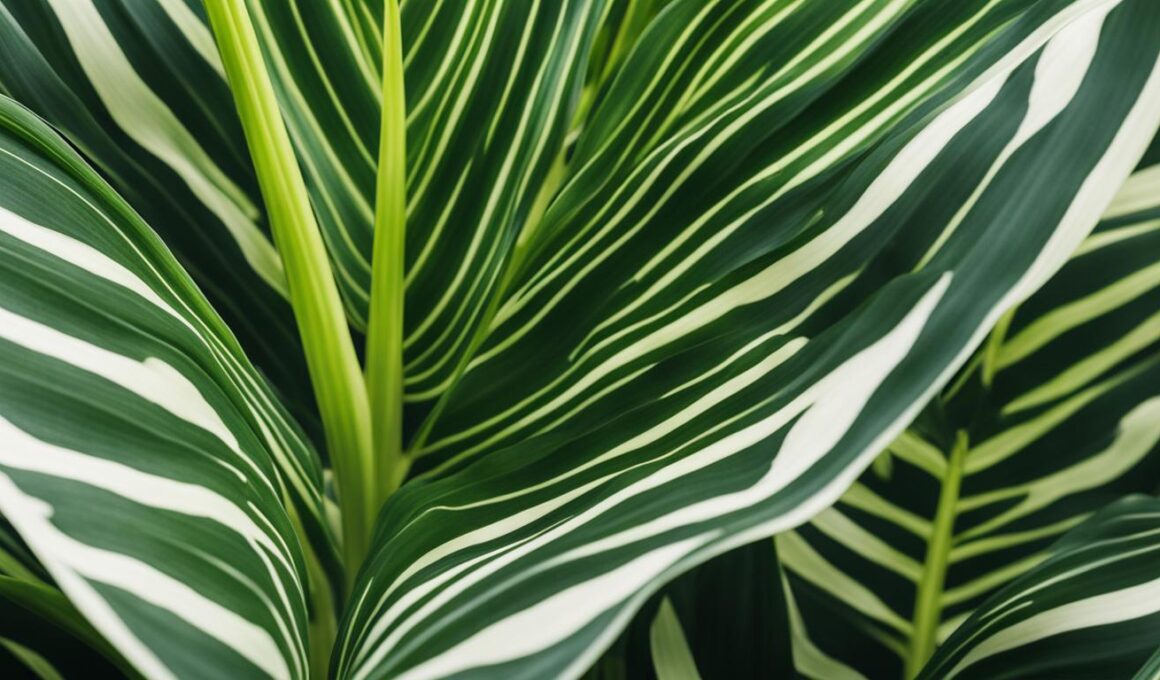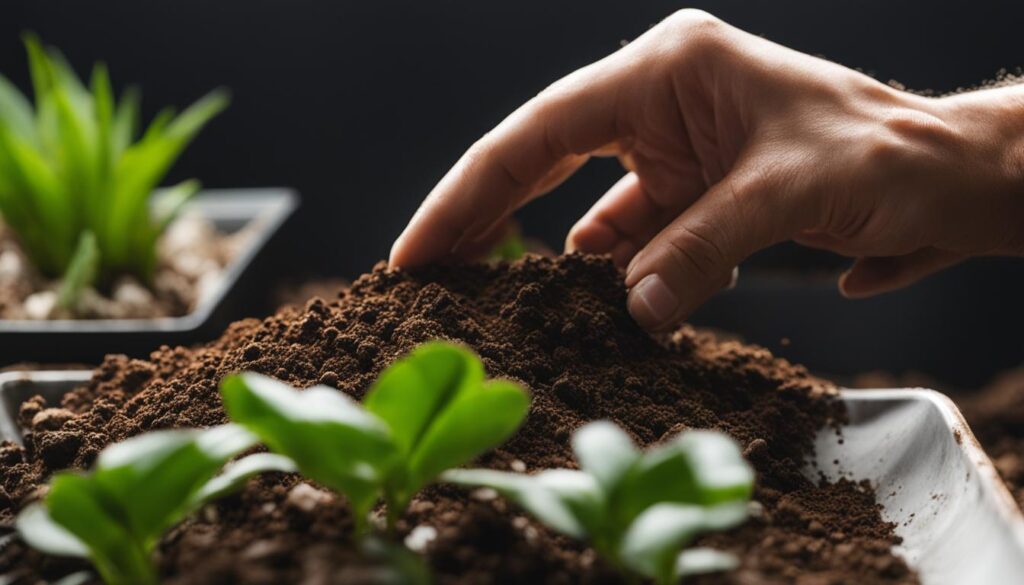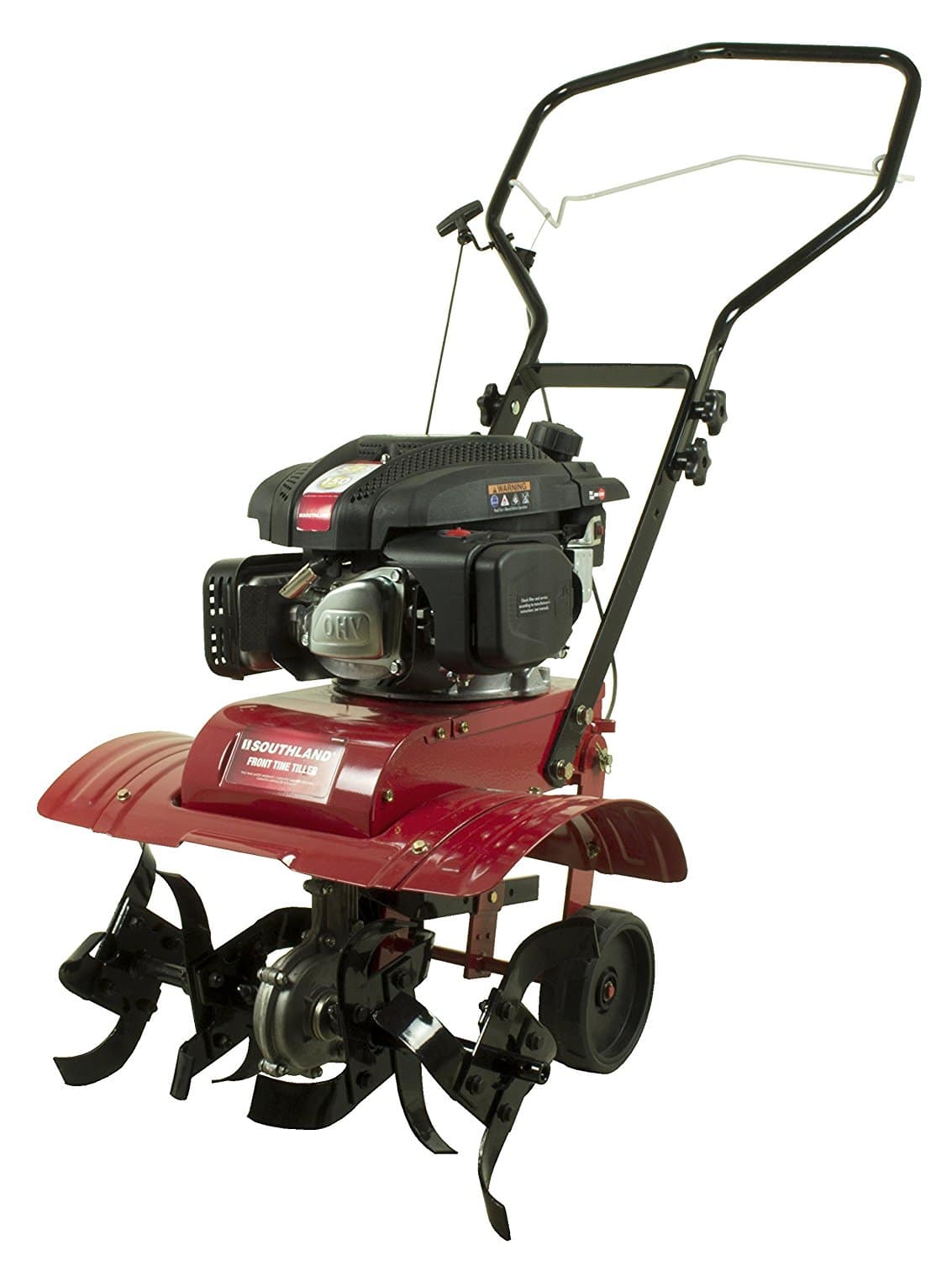Belonging to the Marantaceae family, Calathea White Star presents a striking blend of Pinstripe Calathea elegance and Rosy Calathea’s pastel hues. This prayer plant brightens dim spaces with its warm glow and requires attentive care to thrive. With its non-toxic properties, it is safe for pets, earning it a reputation as a friend to pet owners. Calathea White Star boasts a moderate to fast growth rate, reaching heights of up to 4-5 feet indoors, promising to be a rewarding addition for those willing to commit to its care requirements.
Key Takeaways
- Calathea White Star is a beautiful prayer plant that enhances any indoor space.
- The plant requires medium to bright indirect light, providing a minimum of 5 hours daily.
- Watering practices include using filtered, distilled, or dehumidifier-collected water for optimal leaf health.
- Creating a well-draining, nutrient-dense soil mix is essential for the plant’s overall health and growth.
- Maintain temperatures between 65°F and 85°F, avoiding temperature shocks and drafts for ideal conditions.
- High humidity levels are required, and tactics such as using a humidifier or pebble tray can help maintain these levels.
- Fertilize your Calathea White Star during growth seasons, skipping the colder months to promote healthy growth.
Meet the Calathea White Star: A Striking Addition to Your Indoor Garden
The unique Calathea White Star is a perfect choice for plant enthusiasts looking to enhance their indoor garden with a vibrant and striking houseplant. This captivating species belongs to the Marantaceae family, commonly known as the prayer plant family. Showcasing its animated nature, the Calathea White Star has the ability to move its foliage in response to light variations and time of day, making it an eye-catching addition that is sure to impress.
One of the most alluring Calathea White Star features is its gorgeous leaves, which are adorned with green, pink, and white pinstripes. The deep burgundy underside of the leaves expertly emphasizes the striking leaf patterns, further enhancing the overall aesthetic appeal of this beautiful plant.
To properly care for your Calathea White Star and bring its full potential to life, it is critical to provide an ideal environment that caters to its unique requirements. In doing so, your indoor oasis will be graced with a truly magnificent specimen that will undoubtedly become the focal point of your indoor garden.
When it comes to creating the perfect conditions for your Calathea White Star, several key factors must be taken into consideration:
- Light requirements
- Watering techniques
- Soil preferences
- Temperature and humidity needs
- Fertilization schedule
By nurturing your Calathea White Star with the appropriate care, you can rest assured that this stunning houseplant will not only survive but thrive under your attentive stewardship.
| Characteristic | Description |
|---|---|
| Leaf appearance | Green and pink to white pinstripes with a burgundy underside |
| Foliage movement | Responsive to light variations and time of day (prayer plant) |
| Light requirements | Medium to bright indirect sunlight |
| Watering frequency | When topsoil dries |
| Soil preferences | Well-draining, nutrient-dense potting mix |
| Temperature range | 65°F to 85°F |
| Humidity requirements | High humidity levels |
| Fertilization schedule | Periodically during growth seasons |
In conclusion, the Calathea White Star is an incredible addition to any indoor garden, providing a mesmerizing display of colorful foliage and captivating movement. With the proper care and attention to its unique needs, this striking houseplant can become the centerpiece of your living space, creating an enchanting environment that will leave a lasting impression on all who experience it.
Light Requirements for Calathea White Star
To maintain its vivid colors and patterns, Calathea White Star yearns for a habitat bathed in medium to bright indirect light. It is recommended to provide a minimum of 5 hours of filtered sunlight per day, positioning it to avoid direct rays which can lead to fading and damage.
Choosing the Ideal Spot for Bright, Indirect Exposure
To achieve optimal Calathea White Star care, placing your plant in a location that receives medium to bright indirect sunlight is crucial. Ensure that the area avoids direct sun rays by using sheer curtains or placing the plant near a north-facing or east-facing window. This will allow your prayer plant protection from sunlight damage while still receiving the ample light it requires to thrive.
- Install sheer curtains to filter sunlight.
- Place your plant near a north-facing or east-facing window.
- Avoid locations directly exposed to harsh sunlight.
Consequences of Direct Sunlight on Your Plant’s Foliage
Exposing Calathea White Star to direct sunlight poses the risk of washed-out colors and diminished leaf patterns. Direct rays can be harmful, emphasizing the need for strategic placement within the indoor environment to shield this sensitive plant from the harsh effects of the sun.
Direct sunlight can lead to:
- Leaf scorching – Causing burnt tips and brown spots on the leaves.
- Fading foliage – Loss of vibrant color and pattern vibrancy due to intense sun rays.
- Stunted growth – Hindered development of new leaves and plant structures.
| Light Condition | Features | Effects on Calathea White Star |
|---|---|---|
| Medium to Bright Indirect Sunlight | Filtered sunlight, north or east-facing windows, and sheer curtains. | Healthy growth, vibrant foliage, and well-defined leaf patterns. |
| Direct Sunlight | Unfiltered sunlight, south or west-facing windows, and bare windows. | Scorched leaves, fading colors, and stunted growth. |
By adhering to Calathea Light Requirements and finding the ideal plant location, you can maintain the health and beauty of your Calathea White Star, ensuring its striking foliage flourishes within your home environment.
Proper Watering Techniques for Your Calathea White Star
Calathea White Star’s vitality depends on its ability to access high moisture levels, making it essential for plant caretakers to master appropriate indoor plant hydration techniques. To keep your Calathea White Star thriving, ensure you water it thoroughly once the top inches of the soil dry out. Combine well-draining soil and a container with drainage capacity to prevent waterlogging and root rot.
Water quality plays a critical role in maintaining the plant’s exquisite appearance, as tap water chemicals may lead to leaf browning and damage. Instead, opt for filtered, distilled, or dehumidifier-collected water – these alternatives are devoid of harmful elements and are better suited for Calathea White Star hydration.
Calathea Watering Frequency
- Consistently moist soil during the growing season (spring and summer)
- More infrequent watering during dormancy (fall and winter)
- Adjust the watering schedule based on humidity, temperature, and light conditions
Proper watering entails keeping an eye on the plant’s specific needs and environmental conditions. Here are some general guidelines for maintaining optimal moisture levels:
| Season | Watering Frequency | Additional Tips |
|---|---|---|
| Spring & Summer | Once a week | Monitor soil moisture; adjust as needed based on conditions. |
| Fall & Winter | Every 10-14 days | Reduce frequency, as the plant becomes more dormant and requires less water. |
By following these Calathea watering techniques and guidelines, your Calathea White Star will thrive and continue to captivate your indoor space with its unique colors, patterns, and animated movements.
Best Soil Practices for Calathea White Star Growth
Achieving optimal growth for your Calathea White Star begins with the proper soil selection and maintenance. In this section, we will delve into the ideal potting mix and ways to prevent common soil-related issues to ensure your plant’s health.
The Ideal Potting Mix
A well-draining, nutrient-dense potting mix brimming with organic matter provides the perfect foundation for Calathea White Star. Coco coir or peat-based mediums are generally recommended due to their ability to promote healthy root growth while also maintaining proper moisture. However, it’s crucial to avoid water-retentive additives to prevent root rot.
For a custom Calathea soil mix, consider blending the following components:
- 40% coco coir or peat moss
- 30% perlite or pumice
- 20% organic compost
- 10% bark, charcoal, or orchid mix
Warding Off Common Soil Issues
Vigilance in soil moisture management is essential to circumvent issues such as root rot. Thus, it’s vital for enthusiasts to ensure that the soil remains adequately moist without becoming waterlogged. To strike the perfect balance for Calathea soil health, consider using soil mixes without water-absorbing crystals and follow nutrient-rich potting practices.
Keep an eye on the following indicators to maintain ideal Calathea White Star soil conditions:
- Ensure the soil dries out slightly between watering sessions but never dries completely.
- Inspect the plant’s roots periodically for signs of rot or damage, and address concerns promptly.
- Repot your Calathea White Star every 1-2 years to refresh the soil and promote healthy growth.
- Use pots with drainage holes to prevent water accumulation and potential root rot.
By selecting a suitable potting mix and paying close attention to your plant’s moisture needs, your Calathea White Star will enjoy a healthy, robust growth within its optimal soil environment.
Temperature Considerations for a Happy Calathea White Star
Thriving in the warmth, Calathea White Star finds comfort in temperatures ranging from 65°F to 85°F. As a tropical plant, it prefers warmer environments that simulate its natural habitat. However, stagnant, hot air is unfavorable as it can foster pests and mold, so ensuring good air circulation is essential. Let’s explore some key temperature care tips that will help your Calathea White Star flourish.
- Maintain optimal temperature range: Keep your Calathea White Star in a room with temperatures between 65°F and 85°F, as it thrives within this range.
- Avoid temperature fluctuations: The plant’s proximity to drafts, whether from windows, doors, or air conditioning, should be carefully regulated to avoid temperature shocks harmful to its well-being.
- Ensure good air circulation: Proper air circulation will prevent the buildup of stagnant, hot air that can result in pest infestations and mold growth.
By adhering to these tropical plant care guidelines, you will be fostering an environment that encourages the healthy growth of your Calathea White Star. Consistent temperature management and air circulation will provide your prized houseplant with the conditions it needs to thrive and showcase its stunning foliage.
Maintaining Ideal Humidity Levels for Calathea White Star
High humidity is essential for the Calathea White Star as it thrives in tropical environments. In this section, we will discuss various indoor plant humidity solutions to create a humid microclimate and identify Calathea humidity issues that may occur due to low humidity levels.
Creating a Humid Microclimate
Calathea White Star has specific humidity requirements that can be met by adopting various practices to boost ambient humidity around the plant. Some effective methods include:
- Using a humidifier
- Placing a pebble tray filled with water beneath the plant pot
- Positioning the plant close to other humidity-loving plants
- Regularly misting the foliage with water
Creating a localized humid environment will help your Calathea White Star emulate its native tropical habitat and flourish indoors.
Detecting and Addressing Low Humidity Symptoms
Low humidity could result in various Calathea humidity issues. Some common, yet easily detectable, low humidity indicators include:
- Curling leaves
- Browning leaf edges
- Yellowing or drooping foliage
- Stunted growth
If you notice any of these symptoms, it is crucial to address the humidity issues immediately. Consider placing your Calathea White Star in naturally moist areas, such as kitchens and bathrooms, or use supplemental humidity equipment to find the balance your plant craves. By being attentive to your plant’s needs and maintaining ideal humidity levels, you can ensure a thriving, healthy Calathea White Star.
Fertilizing Your Calathea White Star: Tips for Nutrient-Rich Growth
Appropriate houseplant nutrition is a vital aspect of maintaining a healthy Calathea White Star. Adherence to a proper Calathea fertilizing schedule ensures your plant receives the much-needed nutrients to grow and thrive.
During active growth seasons, which typically fall within spring and summer, it is recommended to provide a diluted, complete liquid fertilizer every three to four weeks. However, it is important to avoid fertilizing during dormancy in the colder months.
To further enrich the soil, consider adding natural additives such as:
- Seaweed
- Fish emulsion
- Worm castings
These additives bolster nutrient availability, fostering a flourishing indoor specimen.
| Growth Stage | Fertilizer Type | Fertilizing Frequency |
|---|---|---|
| Active Growth (Spring and Summer) | Diluted, complete liquid fertilizer | Every 3-4 weeks |
| Dormant (Winter) | N/A | No fertilizer |
By incorporating these fertilizing practices into your Calathea White Star care routine, you provide a nutrient-rich environment conducive to healthy and vibrant growth. Always remember to monitor your plant’s responses to adjustments in its care, and adjust as necessary to ensure its ongoing health and beauty.
Is Calathea White Star a Low Light Houseplant Option?
Yes, Calathea White Star is one of the true low light houseplants. It thrives in medium to low light conditions, making it a great option for areas with limited natural light. Its unique foliage and easy care requirements make it a popular choice for indoor plant lovers looking for low light options.
Conclusion
In summary, Calathea White Star care revolves around a few essential factors: light, water, soil, temperature, humidity, and nutrition. With proper attention to these elements, the Calathea White Star can truly shine and become a striking centerpiece in your indoor garden. This plant, which boasts elegant foliage and pastel hues, brings the beauty of the tropics into the comfort of your home.
Providing the ideal indoor environment for your Calathea White Star involves offering bright, indirect light and maintaining the appropriate temperature and humidity levels. Ensuring the plant is well-watered without waterlogging the soil and supplying the proper nutrients through appropriate fertilization are crucial steps in securing the thriving growth of your plant.
The dedication invested in the care of your Calathea White Star will be generously rewarded when your living space is transformed into a vibrant, lush haven reminiscent of the plant’s native tropical habitat. With attention to detail and adherence to the principles outlined in this guide, the Calathea White Star will continue being a unique and captivating addition to your collection of thriving indoor plants.











